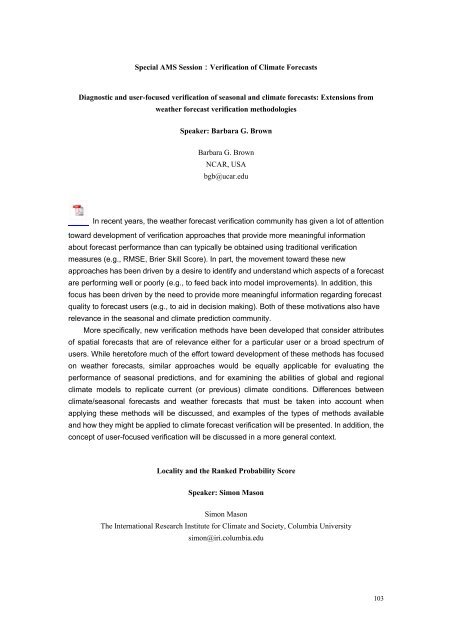The tenth IMSC, Beijing, China, 2007 - International Meetings on ...
The tenth IMSC, Beijing, China, 2007 - International Meetings on ...
The tenth IMSC, Beijing, China, 2007 - International Meetings on ...
Create successful ePaper yourself
Turn your PDF publications into a flip-book with our unique Google optimized e-Paper software.
Special AMS Sessi<strong>on</strong>:Verificati<strong>on</strong> of Climate Forecasts<br />
Diagnostic and user-focused verificati<strong>on</strong> of seas<strong>on</strong>al and climate forecasts: Extensi<strong>on</strong>s from<br />
weather forecast verificati<strong>on</strong> methodologies<br />
Speaker: Barbara G. Brown<br />
Barbara G. Brown<br />
NCAR, USA<br />
bgb@ucar.edu<br />
In recent years, the weather forecast verificati<strong>on</strong> community has given a lot of attenti<strong>on</strong><br />
toward development of verificati<strong>on</strong> approaches that provide more meaningful informati<strong>on</strong><br />
about forecast performance than can typically be obtained using traditi<strong>on</strong>al verificati<strong>on</strong><br />
measures (e.g., RMSE, Brier Skill Score). In part, the movement toward these new<br />
approaches has been driven by a desire to identify and understand which aspects of a forecast<br />
are performing well or poorly (e.g., to feed back into model improvements). In additi<strong>on</strong>, this<br />
focus has been driven by the need to provide more meaningful informati<strong>on</strong> regarding forecast<br />
quality to forecast users (e.g., to aid in decisi<strong>on</strong> making). Both of these motivati<strong>on</strong>s also have<br />
relevance in the seas<strong>on</strong>al and climate predicti<strong>on</strong> community.<br />
More specifically, new verificati<strong>on</strong> methods have been developed that c<strong>on</strong>sider attributes<br />
of spatial forecasts that are of relevance either for a particular user or a broad spectrum of<br />
users. While heretofore much of the effort toward development of these methods has focused<br />
<strong>on</strong> weather forecasts, similar approaches would be equally applicable for evaluating the<br />
performance of seas<strong>on</strong>al predicti<strong>on</strong>s, and for examining the abilities of global and regi<strong>on</strong>al<br />
climate models to replicate current (or previous) climate c<strong>on</strong>diti<strong>on</strong>s. Differences between<br />
climate/seas<strong>on</strong>al forecasts and weather forecasts that must be taken into account when<br />
applying these methods will be discussed, and examples of the types of methods available<br />
and how they might be applied to climate forecast verificati<strong>on</strong> will be presented. In additi<strong>on</strong>, the<br />
c<strong>on</strong>cept of user-focused verificati<strong>on</strong> will be discussed in a more general c<strong>on</strong>text.<br />
Locality and the Ranked Probability Score<br />
Speaker: Sim<strong>on</strong> Mas<strong>on</strong><br />
Sim<strong>on</strong> Mas<strong>on</strong><br />
<str<strong>on</strong>g>The</str<strong>on</strong>g> <str<strong>on</strong>g>Internati<strong>on</strong>al</str<strong>on</strong>g> Research Institute for Climate and Society, Columbia University<br />
sim<strong>on</strong>@iri.columbia.edu<br />
103






![final_program_abstracts[1]](https://img.yumpu.com/19102520/1/174x260/final-program-abstracts1.jpg?quality=85)









